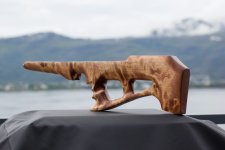A glance of my inside-and-out restored Walthers. (LGR RT/2 LGR universals/LG90/LGV. And a Walther mod 55 that soon will be finished.
As you notice they are all scoped, since I prefer plinking at different distances. 10 m target shooting with diopters is not my thing, and these 40-60 years old rifles are capable for a lot more than 10m.


As you notice they are all scoped, since I prefer plinking at different distances. 10 m target shooting with diopters is not my thing, and these 40-60 years old rifles are capable for a lot more than 10m.
